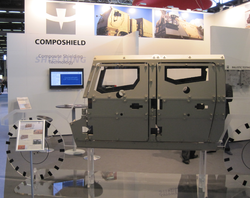
Back درع مركب Arabic Kompozit zirehlər Azerbaijani Композитна броня Bulgarian Verbundpanzerung German Blindaje compuesto Spanish زره کامپوزیت Persian Blindage composite French שריון מרוכב HE Lapisan armor komposit ID Blindaggio in compositi Italian
This article needs additional citations for verification. (September 2009) |










Composite armour is a type of vehicle armour consisting of layers of different materials such as metals, plastics, ceramics or air. Most composite armours are lighter than their all-metal equivalent, but instead occupy a larger volume for the same resistance to penetration. It is possible to design composite armour stronger, lighter and less voluminous than traditional armour, but the cost is often prohibitively high, restricting its use to especially vulnerable parts of a vehicle. Its primary purpose is to help defeat high-explosive anti-tank (HEAT) projectiles.
HEAT had posed a serious threat to armoured vehicles since its introduction in World War II. Lightweight and small, HEAT projectiles could nevertheless penetrate hundreds of millimetres of the most resistant steel armours. The capability of most materials for defeating HEAT follows the "density law", which states that the penetration of shaped charge jets is proportional to the square root of the shaped charge liner density (typically copper) divided by the square root of the target density. On a weight basis, lighter targets are more advantageous than heavier targets, but using large quantities of lightweight materials has obvious disadvantages in terms of mechanical layout. Certain materials have an optimal compromise in terms of density that makes them particularly useful in this role.[2]
- ^ "Leclerc Main Battle Tank". www.tanks-encyclopedia.com. Archived from the original on 2 February 2019. Retrieved 27 April 2022.
- ^ Evaluation of Siliceous Cored Armor for the XM60 Tank Archived June 5, 2011, at the Wayback Machine
© MMXXIII Rich X Search. We shall prevail. All rights reserved. Rich X Search